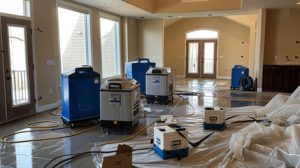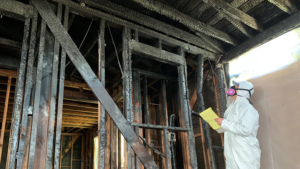Whether it’s natural disasters or plumbing leaks, Water Damage Salt Lake City can cause irreparable damage to your home and possessions. Preventing and addressing it quickly can save money and prevent health hazards like mold growth.

Visible stains or discoloration on surfaces are common signs of water damage, but it’s also important to check for hidden areas where a leak might occur.
Water damage can cause significant structural deterioration in buildings and lead to severe consequences for your personal belongings. Sentimental items, valuables, and important documents are often damaged beyond repair by water intrusion. In addition, persistent leaks can weaken beams and corrode foundations, leading to visible cracks in walls and floors as well as sagging or bulging walls. Persistent and unaddressed leaks can also significantly increase your water bill.
Leaks can occur from various causes, including plumbing issues and drainage backflows. The most common sign of a leak is stains and discoloration on ceilings or walls. If you notice these stains, it is important to investigate as soon as possible.
Other signs of water damage include a musty smell and damp or spongy areas. Damp or spongy areas are a clear indication that there is a leaking pipe somewhere nearby. A musty odor is another sign that there has been significant mold growth or water damage in the area for a long time.
A sudden and unexplained increase in your water bill is a clear indicator of a water leak somewhere in your home or business. Unaddressed leaks can cause significant structural damage to your property over time, resulting in expensive repairs and replacements.
Using a wet/dry vacuum, mop, or towels to remove as much excess water as possible is a good step in the right direction. However, it is also essential to keep in mind that the longer you wait to dry your building and personal belongings, the more significant the damage will become.
If you’re unsure if the water damage is new or old, try touching it. Fresh water damage will have a strong watermark that’s still wet, while old water marks will appear faded and dry.
Water damage can have a negative impact on your personal belongings, causing wood to warp, fabrics to deteriorate, and electronics to short circuit. Sentimental items like photo albums and heirlooms may be irreparably damaged by water damage. While some items can be salvaged with prompt action, preventing the damage from occurring in the first place is always best.
Mold
Molds are fungi that exist everywhere, indoors and outdoors. They thrive in damp environments and are able to spread quickly thanks to airborne spores. When left unchecked, mold growth can cause materials to rot and even lead to respiratory illnesses in building occupants.
If you’re experiencing water damage, you should watch out for any signs of a mildew or mold infestation. This is especially important if you live in an older home or have children. Molds can cause a host of health problems, including allergies, asthma, and other breathing issues. Generally, they’re black or brown in color, though they can also be green, white, pink, and other colors. Regardless of what type of mold it is, all are a sign of serious water damage that needs to be addressed right away.
While visible signs of water damage like stains and discoloration may be easy to spot, the underlying causes of the problem often go unnoticed. This is why it’s important to hire a company with experience in both water damage restoration and general contracting. Inspect for credentials such as membership in professional organizations and certification from the Institute of Inspection, Cleaning and Restoration Certification (IICRC).
Hidden signs of water damage include the smell of a musty or earthy environment, which is usually caused by rotting organic material and mold spores that have been trapped in damp areas. If you notice this smell, it’s crucial to call a water damage remediation company as soon as possible to dry the area and prevent future moisture problems.
It’s also important to turn off any fans or box fans in the affected area so that the air can circulate and help dry the structure. If you have any fabric or upholstered furniture, be sure to move it out of standing water or put wood blocks under the legs to keep them from getting wet.
It’s also a good idea to have water alarms installed so that you can respond as soon as they detect water in your home or building. These gadgets can help prevent severe water damage and minimize the cost of repairs.
Damage to documents
When it comes to the damage caused by water, cellulose-based items like paper and books are often the most affected. They can be discolored, warped, and brittle. Moreover, they may smell unpleasant or even decay. Mold and bacterial growth, which are also common effects of water damage, are particularly dangerous to documents because they can stain or discolor papers.
Water damage is also devastating to photographs and other media, which can be permanently ruined by prolonged exposure to moisture. They can become illegible and disintegrate, while ink can smudge. Additionally, water can cause photos to fade and change color, as well as leave behind unsightly creases. In some cases, these changes can be difficult or impossible to reverse.
The damage to these valuable items can be a great deal of financial pain for homeowners and business owners alike. Many electronic devices are especially susceptible to water damage, such as smartphones and tablets, which can experience irreparable harm from the internal components being exposed to moisture. Similarly, furniture and upholstery can deteriorate, which could reduce the value of a home or business and lead to costly replacements.
Taking preventive measures can help you avoid serious and costly damage to your possessions. In addition to storing items on shelves and elevating them, you can use plastic storage bins or sealable bags that are designed to withstand water damage. Additionally, you can keep digital backups of important documents and photographs so that they are protected in case the originals are damaged by water.
If you are dealing with a flood, the best thing to do is seek professional assistance. This is because they will have the equipment and expertise to treat the damage and salvage as much of your belongings as possible. Additionally, they can assess the damage and provide you with tips to minimize the impact of further water damage.
If you are experiencing water damage, you should take several steps to protect your important documents and photos until professionals arrive. For example, you can blot the water-damaged items with clean towels and sponges to absorb as much moisture as possible. Alternatively, you can interleave the pages of your important books and documents with butcher paper or paper towels and place them in a milk crate. Lastly, you can place the items in the freezer to slow down the degradation process.
Sentimental items
When it comes to protecting your belongings from the damage caused by water, the first step is often identifying which items have the most meaning to you and that should be prioritized in the aftermath of a flood. Whether based on price or sentiment, items like photos, heirlooms, and special mementos can be especially devastating when they’re destroyed by water. In addition, important documents and electronics are often a priority for protection as they can be difficult or impossible to replace and contain vital personal information.
The sensitivity of these items to water damage makes it even more critical to act quickly to prevent irreparable damage. To safeguard these valuables, it’s important to make copies and store them safely away from your home or business in a location that is less prone to flooding. It is also a good idea to store important papers in airtight containers and place delicate memorabilia in acid-free archival sleeves. Finally, be sure to regularly inspect your plumbing and roof for signs of water damage.
If an item is particularly expensive or has a high sentimental value, it’s often worth the effort to restore it. However, if an item is no longer functional and has minimal monetary or sentimental value, it may be best to let it go.
Sentimental clutter can take up a lot of space and is often found in the most unexpected places. Items like baby toys, a band t-shirt from an old relationship, or artwork are just some examples of the kinds of things that many people have trouble letting go. If an object doesn’t bring you happiness or trigger a happy memory, consider giving it to a friend or donating it to charity.
Water damage is one of the most destructive forces in the world, costing businesses and homeowners billions of dollars each year. Although it is common to focus on the dangers of fire, it’s equally dangerous to ignore the effects of water damage. In addition to the emotional and financial burdens, water damage can cause structural damage that compromises your property and leads to costly repairs.
